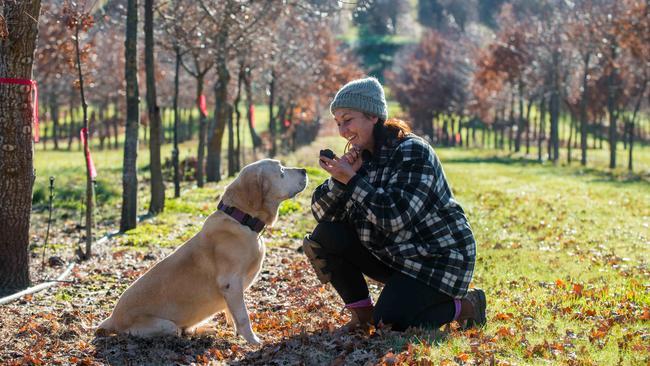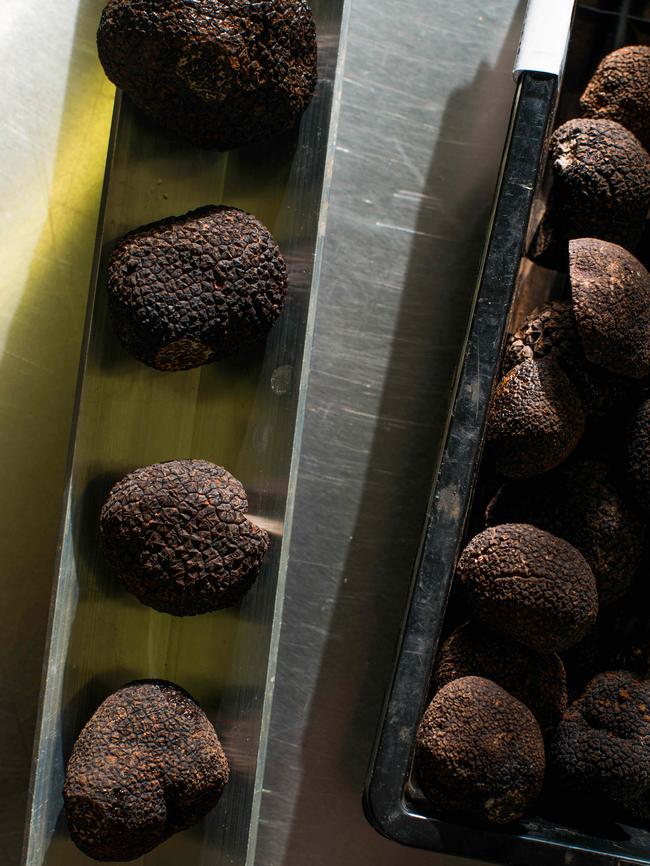At $2500 a kilo, truffle crop not to be sniffed at
Truffle-hunting dogs are unearthing a record harvest in Tasmania.

Red ribbons tied to the English oaks lining Mark Bowerman’s farm are like victory banners hoisted after battle.
In many ways, that’s exactly what they are, thanks to the efforts of Bowerman’s oldest and most trusted truffle-hunting labrador, 12-year- old Bundi.
Bundi and his fellow truffle dogs have unearthed 220kg of “black gold” buried beneath the 20,000 oak trees on the “Truffles of Tasmania” farm near Deloraine since the first hunting day in early June. In the same four weeks last year, just 40kg of black truffle, worth as much as $2500 a kilo, had been sniffed out of the soil surrounding the trees where the fungi starts growing over summer.
It points to this dry clear winter yielding a truffle bonanza for Tasmania, where Australia’s first precious black truffles were harvested in June 1999 by Tim Terry, on a farm just down the road from Bowerman’s plantation.
Bowerman hopes to reap a record one-tonne crop this year from beneath the 13 to 17-year-old trees on his 50ha farm, Australia’s biggest trufferiere.
“We’re getting truffles from trees and areas where we have never had them before,” he said yesterday as his partner and the farm’s head truffle grader, Julie Donahue, harvested ripe truffle “balls” found by an excited Bundi in the early-morning frost.
“We’ve done a few things that we think might encourage them but there’s still no way you can guarantee every tree will produce truffles every year; it’s not like growing a bag of spuds, and I sort of hope it always stays like that.”
Truffles are a type of fungi that grows symbiotically on the root of just a few host trees — usually English oaks, hazelnuts or the evergreen Spanish or holm oak — traditionally found wild in the forests of southern France and northern Italy in mid-winter.

But Australia has now become a major producer and exporter of the best black truffles, with the eight-tonne annual crop supplied to top European, Asian and American chefs and restaurants in their summer, counter-seasonal to local production.
About one third of Bowerman’s three-month truffle harvest is sold overseas, dispatched by air every day just a few hours after being unearthed and classed into four grades by Donahue in the farm’s testing laboratory. A golf-ball sized truffle weighing 60g will set a diner back $100.
Central to the hunt are the truffle dogs trained by Donahue from an early age.
Pigs, traditionally boars in the wild French forests, are not used in Australia as they often refuse to relinquish the truffle once found, supposedly because it smells like female pheromones. “There’s a lot of French hunters with no fingers left; no thank you,” says Bowerman dryly.
While breed is not important — Bundi is a Labrador but others such as fellow dogs Copper, Rex, Sky and Buster are spaniels, setters and even kelpies — Donahue says only one in 100 pups will have the unique combination of hyperactivity, a keen sense of small and a persistent wish to please that the best truffle-hunting dogs possess.
The dogs are first trained with treats dipped in fake truffle oil. Eventually they will be able to detect the smell of a buried ripe truffle from several metres away, and learn to paw and bark at the spot where the treasure is buried.
A treat is dispensed, the soil smelt to see if the aroma is strong enough to suggest the truffle is ripe picking, and the chosen few carefully pocketed into small bags.
A ribbon is tied around the tree to show it has yielded a truffle this season — and that more are therefore likely to be found. Red ribbons are everywhere this year.
“It’s really just a glorified mushroom but it’s the mystery about it all I love,” says Donahue, whose record find is a 645g truffle worth more than $1000. “You can walk all day and not find one and then, bang, there one is; it’s like looking for black gold.”
